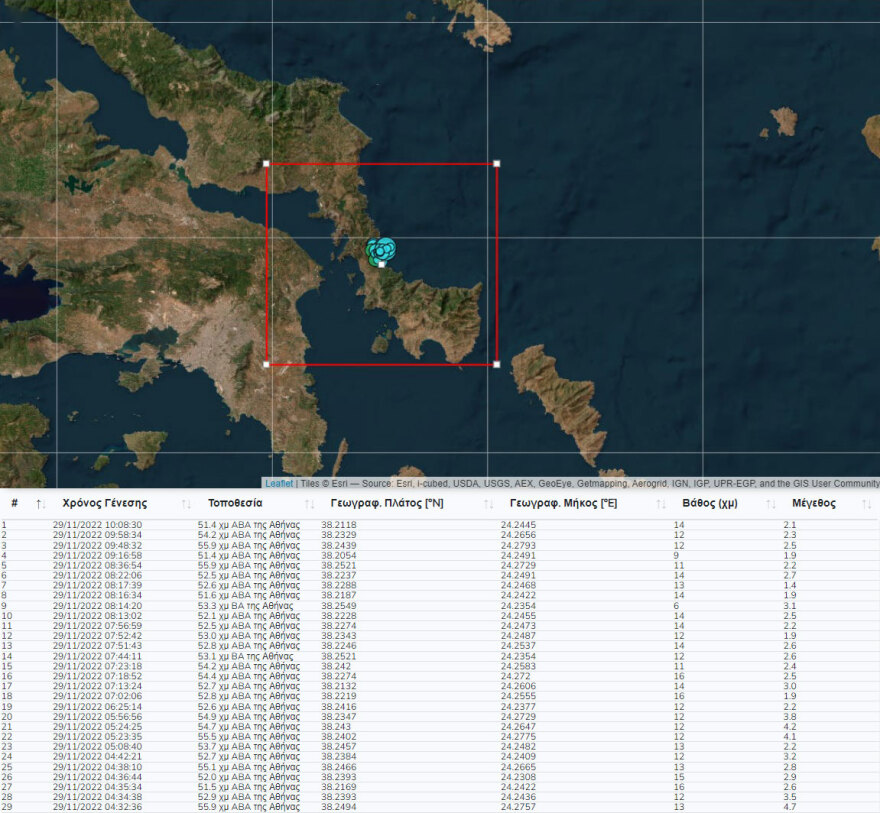
For many years and until Tuesday morning (29/11) the area in the south Euboea Not giving strongly Earthquake Greater than 4 on the Richter scale, while earthquakes as low as 4 on the Richter scale, although not rare, are enough to consider this area one of the safest in Greece.
Unknown split who gave 4.8 Richter Then two more earthquakes of magnitude 4.1 and 4.2 entered the “microscope” of scientists who are now monitoring the evolution of the event.
“This area was considered one of the safest in Greece for many years, even before the last earthquake regulation. Although the study of anti-seismic control was carried out in this area, no risk was considered, because it did not cause any destructive earthquake and major seismic event” Geodynamic Institute protothema.gr says Vasilis Karastadis.
So far they have been mentioned Dozens of aftershocks 9 kilometers southeast of Zaragoza in southern Evia from the same earthquake.

“The portion is very limited Earth quake And that’s a good thing and a bad thing. The good thing is that you don’t expect anything big because there is no history of strong earthquakes. On the other hand, it is an area that has not been tested for earthquakes, so it has very vulnerable buildings and people are not aware of this phenomenon. So we are talking about an area that is less seismic and that is currently being treated. 4.8 The Richter sequence can evolve normally, but many aftershocks must be collected to check their evolution. If there are not enough events in 48 hours, we will need more time to conclude that this is also a major earthquake,” said Mr. Karastadis.
According to Scientists The part that appears to be activated by split It is about ten kilometers long, but because it was not known until the 4.8 magnitude earthquake, no one can describe its features at present.
“Since we don’t have much information about this area, Th Earthquakes Now we have because they show evidence of faults in the area and we see the mechanism of the earthquake. It helps us scientifically. A split has been implemented, but we will know the details of that particular split when an analysis is done and decisions are made. All we have to say for now is:
– First: The area is less seismic
– Second: It is actually considered a safe area
– Third: There have never been strong events and destructive earthquakes,
– Fourth: The world is not well-informed and still not the same sensitive in terms of precautionary measures in the construction of houses, while the old anti-seismic regulations were very favorable to the region,” said Mr. Karastadis.

The previously mentioned seismologist at protothema.gr Gerasimos PapadopoulosA member of the Executive Board of the Hellenic Mediterranean University and a Scientific Partner of UNESCO, 4.8 magnitude earthquake It was “announced” by low intensity earthquakes that started two months ago and for this reason the scientific community must take into account the history of the last two months.
At the same time, it is an area with no significant seismic history, Mr. Papadopoulos explained, but this should not be reassuring as a strong earthquake can occur anywhere in Greece.
“It’s important to note Seismic activity The region began with small-scale earthquakes last October, with the largest earthquake occurring yesterday, November 28, with a magnitude of 3.3. So I’d say the 4.8 magnitude morning earthquake was “announced” by two months of aftershocks. So, we scientists need to take into account this history of the last two months to see if 4.8 is significant or not. Will have to wait a few days to get a more definitive opinion.
About Seismic history Mr. from the area. Papadopoulos He explained: “This area does not have a significant history of strong earthquakes, but there is no guarantee that it will not intensify. I say this because there are examples of strong earthquakes not only in Greece but in other parts of the world, as happened in the terrible earthquake of Barnita in 1999.
Geologist – Seismologist and Director of Research at the Geodynamic Institute of the National Laboratory of Athens, Athanasios Kanas, explained to protothema.gr that we will have to wait a few days to see how this event will develop. “This is not an area with a history of seismicity. My evidence does not show that the activated rift is large. It may be a seismic sequence that lasts for a few days. In the last decade, there has been no earthquake above magnitude 4 in this area,” he said.
News Today:
The girl went for a massage and the masseuse put his hands inside her underwear
Thessaloniki: 21-year-old student killed by 26-year-old Albanian awarded life prize
World Cup 2022: Upcoming Thriller Matches – Who Qualified, Who’s At Risk
Vasilis Koulas

. “Professional creator. Subtly charming web advocate. Unapologetic problem solver. Devoted student.”





More Stories
Criminal gang in Mykonos encouraged women into prostitution – how they set up romantic dates
Earthquake in Kavtos: “Too early to decide if it’s significant” – Valleys closed, risk of landslides
Halkidiki – Luna Park: SKAI Revelation – Discovered by the Expert